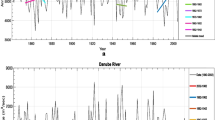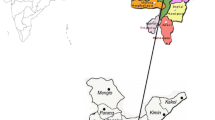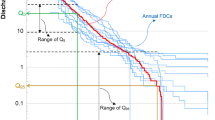Abstract
Application of a deterministic geometric approach for the simulation of highly intermittent hydrologic data is presented. Specifically, adaptations of the fractal-multifractal (FM) method and a Cantorian extension are advanced in order to simulate rainfall records measured at the daily scale and encompassing a water year. It is shown, using as case studies 2 years of rainfall sets gathered in Laikakota, Bolivia and Tinkham, Washington, USA, that the FM approach, relying on only at most 8 parameters, is capable of closely preserving either the whole record’s histogram (therefore including moments), the whole data’s Rényi entropy function and/or the maximum number of consecutive zero values present in the sets, resulting in suitable rainfall simulations, whose overall features and textures are similar to those of the observed sets. The study hence establishes the possibility of simulating highly intermittent sets in time in a deterministic and holistic way as a novel parsimonious methodology to supplement available stochastic frameworks.


Similar content being viewed by others
Abbreviations
- NSH:
-
Nash–Sutcliffe statistic for histograms
- PS90:
-
Percent histogram mass in simulated sets corresponding to 90% in observed data
- NZR:
-
Number of zeroes in observed and (simulated) rainfall sets
- EZR:
-
Percent error of zeros preserved by FM simulation
- NSE:
-
Nash–Sutcliffe statistic for entropies
- MCZ:
-
Maximum consecutive zeros in records and (simulated) sets
- NSA:
-
Nash–Sutcliffe statistic for autocorrelations
References
Barnsley MF (1988) Fractals everywhere. Academic Press, San Diego
Cortis A, Puente CE, Sivakumar B (2009) Nonlinear extensions of a fractal-multifractal approach for environmental modeling. Stoch Environ Res Risk Assess 23(7):897–906
Cortis A, Puente CE, Huang HH, Maskey ML, Sivakumar B, Obregón N (2013) A physical interpretation of the deterministic fractal-multifractal method as a realization of a generalized multiplicative cascade. Stoch Environ Res Risk Assess 28(6):1421–1429
Eagleson PS (1978) Climate, soil, and vegetation, 2, The distribution of annual precipitation derived from observed storm sequences. Water Resour Res 14(5):713–721
Feder J (1988) Fractals. Plenun Press, New York
Fernández Martínez JL, García Gonzalo E, Fernández Álvarez JP, Kuzma HA, Menéndez Pérez CO (2010) PSO: A powerful algorithm to solve geophysical inverse problems: Application to a 1D-DC resistivity case. J Appl Geophys 71(1):13–25
Garbrecht JD, Zhang JX (2012) Generating synthetic daily precipitation realizations for seasonal precipitation forecasts. J Hydrol Eng 19(1):252–264
Geng S, de Vries FWP, Supit I (1986) A simple method for generating daily rainfall data. Agr Forest Meteorol 36(4):363–376
Gupta VK, Waymire EC (1993) A statistical analysis of mesoscale rainfall as a random cascade. J Appl Meteorol 32(2):251–267
Haan CT, Allen DM, Street JO (1976) A Markov chain model of daily rainfall. Water Resour Res 12(3):443–449
Huang HH, Puente CE, Cortis A (2012) Geometric harnessing of precipitation records: reexamining four storms from Iowa City. Stoch Environ Res Risk Assess 27(4):955–968
Huang HH, Puente CE, Cortis A, Fernández Martínez JL (2013) An effective inversion strategy for fractal–multifractal encoding of a storm in Boston. J Hydrol 496:205–216
Jothityangkoon C, Sivapalan M, Viney NR (2000) Tests of a space-time model of daily rainfall in southwestern Australia based on nonhomogeneous random cascades. Water Resour Res 36(1):267–284
Kaczmarska J, Isham V, Onof C (2014) Point process models for fine-resolution rainfall. Hydrolog Sci J 59(11):1972–1991
Kavvas ML, Delleur JW (1981) A stochastic cluster model of daily rainfall sequences. Water Res Res 17(4):1151–1160
Langousis A, Veneziano D (2007) Intensity-duration-frequency curves from scaling representations of rainfall. Water Res Res. doi:10.1029/2006WR005245
Langousis A, Veneziano D, Furcolo P, Lepore C (2009) Multifractal rainfall extremes: theoretical analysis and practical estimation. Chaos, Solitons Fractals 39(3):1182–1194
Langousis A, Carsteanu AA, Deidda R (2013) A simple approximation to multifractal rainfall maxima using a generalized extreme value distribution model. Stoch Environ Res Risk Assess 27(6):1525–1531
Lanza LG, Vuerich E (2009) The WMO field intercomparison of rain intensity gauges. Atmos Res 94(4):534–543
Lovejoy S, Schertzer D (1985) Generalized scale invariance in the atmosphere and fractal models of rain. Water Resour Res 21(8):1233–1250
Lovejoy S, Schertzer D (1990) Multifractals, universality classes and satellite and radar measurements of cloud and rain fields. J Geophys Res 95(3):2021–2034
Mandelbrot BB (1982) The fractal geometry of nature. Freeman, San Francisco
Mandelbrot BB (1989) Multifractal measures especially for the geophysicist. In: Scholz CH, Mandelbro MM (eds) Fractals in geophysics. Birkhanser, Basel, pp 1–42
Maskey ML, Puente CE, Sivakumar B, Cortis A (2015) Encoding daily rainfall records via adaptations of the fractal multifractal method. Stoch Environ Res Risk Assess. doi:10.1007/s00477-015-1201-7
Obregón N, Puente CE, Sivakumar B (2002a) Modeling high resolution rain rates via a deterministic fractal–multifractal approach. Fractals 10(3):387–394
Obregón N, Sivakumar B, Puente CE (2002b) A deterministic geometric representation of temporal rainfall. Sensitivity analysis for a storm in Boston. J Hydrol 269(3–4):224–235
Puente CE (1996) A new approach to hydrologic modelling: derived distribution revisited. J Hydrol 187:65–80
Puente CE (2004) A universe of projections: may Plato be right? Chaos, Solitons Fractals 19(2):241–253
Puente CE, Obregón N (1996) A deterministic representation of temporal rainfall: result for a storm in Boston. Water Resour Res 32(9):2825–2839
Puente CE, Sivakumar B (2007) Modeling hydrologic complexity: a case for geometric determinism. Hydrol Earth Syst Sc 11:721–724
Rodríguez-Iturbe I, Cox DR, Isham V (1987) Some models for rainfall based on stochastic point processes. Proc R Soc Lond A 410(1839):269–288 (The Royal Society)
Rodríguez-Iturbe I, Febres de Power B, Sharifi MB, Georgakakos KP (1989) Chaos in rainfall. Water Resour Res 25(7):1667–1675
Schertzer D, Lovejoy S (1987) Physical modeling and analysis of rain and clouds by anisotropic scaling of multiplicative processes. J Geophy Res 92:9693–9714
Sivakumar B (2000) Chaos theory in hydrology: important issues and interpretations. J Hydrol 227(1–4):1–20
Sivakumar B, Berndtsson R, Olsson J, Jinno K (2001) Evidence of chaos in the rainfall-runoff process. Hydrolog Sci J 46(1):131–145
Tessier Y, Lovejoy S, Schertzer D (1993) Universal multifractals: Theory and observations for rain and clouds. J Appl Meteorol 32:223–250
Tsonis AA, Elsner JB, Georgakakos KP (1993) Estimating the dimension of weather and climate attractors: important issues about the procedure and interpretation. J Atmos Sci 50(15):2549–2555
Vandenberghe S, Verhoest NEC, Onof C, De Baets B (2011) A comparative copula-based bivariate frequency analysis of observed and simulated storm events: a case study on Bartlett-Lewis modeled rainfall. Water Resour Res 47(7):1–16
Veneziano D, Langousis A (2005) The areal reduction factor: a multifractal analysis. Water Resour Res. doi:10.1029/2004WR003765
Veneziano D, Langousis A (2010) Scaling and fractals in hydrology. In: Sivakumar B, Berndtsson R (eds) Advances in data-based approaches for hydrologic modeling and forecasting. World Scientific, Singapore
Veneziano D, Langousis A, Furcolo P (2006) Multifractality and rainfall extremes: A review. Water Resour Res. doi:10.1029/2005WR004716
Veneziano D, Langousis A, Lepore C (2009) New asymptotic and preasymptotic results on rainfall maxima from multifractal theory. Water Resour Res. doi:10.1029/2009WR008257
Acknowledgements
The research leading to this article was supported by a JASTRO Award provided to the first author by the University of California, Davis. We are thankful to Ministerio de Medio Ambiente y Agua, Bolivia for providing rainfall records gathered at Laikakota and also to the team of National Resource Conservation Service for the availability of rainfall records in its web portal. Bellie Sivakumar acknowledges the financial support from the Australian Research Council (ARC) through the Future Fellowship Grant awarded to him (FT110100328). Comments and suggestions by anonymous reviewers helped improve the manuscript and are gratefully acknowledged.
Author information
Authors and Affiliations
Corresponding author
Appendix 1: Parameter values for FM representation of Figs. 3–8
Appendix 1: Parameter values for FM representation of Figs. 3–8
A measured set of daily rainfall at Laikakota, Bolivia gathered from September 1965 to May 1966 (top), followed by its histogram, Rényi entropy and autocorrelation functions; and four suitable rainfall simulations (bottom), based on fits of the records’ histogram. While simulations A and B emanate from fractal wires, C and D come from Cantorian attractors. While sets A and C use a horizontal threshold, B and D employ a vertical one
A measured set of daily rainfall at Laikakota, Bolivia gathered from September 1965 to May 1966 (top), followed by its histogram, Rényi entropy and autocorrelation functions; and four suitable rainfall simulations (bottom), based on fits of the records’ entropy function. While simulations A and B emanate from fractal wires, C and D come from Cantorian attractors. While sets A and C use a horizontal threshold, B and D employ a vertical one
A measured set of daily rainfall at Laikakota, Bolivia gathered from September 1965 to May 1966 (top), followed by its histogram, Rényi entropy and autocorrelation functions; and four suitable rainfall simulations (bottom), based on fits of the records’ distribution of zeros. While simulations A and B emanate from fractal wires, C and D come from Cantorian attractors. While sets A and C use a horizontal threshold, B and D employ a vertical one
A measured set of daily rainfall at Tinkham Creek, Washington gathered from October 2000 to September 2001 (top), followed by its histogram, Rényi entropy and autocorrelation functions; and four suitable rainfall simulations (bottom), based on fits of the records’ histogram. While simulations A and B emanate from fractal wires, C and D come from Cantorian attractors. While sets A and C use a horizontal threshold, B and D employ a vertical one
A measured set of daily rainfall at Tinkham Creek, Washington gathered from October 2000 to September 2001 (top), followed by its histogram, Rényi entropy and autocorrelation functions; and four suitable rainfall simulations (bottom), based on fits of the records’ entropy function. While simulations A and B emanate from fractal wires, C and D come from Cantorian attractors. While sets A and C use a horizontal threshold, B and D employ a vertical one
A measured set of daily rainfall at Tinkham Creek, Washington gathered from October 2000 to September 2001 (top), followed by its histogram, Rényi entropy and autocorrelation functions; and four suitable rainfall simulations (bottom), based on fits of the records’ distribution of zeros. While simulations A and B emanate from fractal wires, C and D come from Cantorian attractors. While sets A and C use a horizontal threshold, B and D employ a vertical one
Rights and permissions
About this article
Cite this article
Maskey, M.L., Puente, C.E. & Sivakumar, B. Deterministic simulation of highly intermittent hydrologic time series. Stoch Environ Res Risk Assess 31, 2719–2732 (2017). https://doi.org/10.1007/s00477-016-1343-2
Published:
Issue Date:
DOI: https://doi.org/10.1007/s00477-016-1343-2










